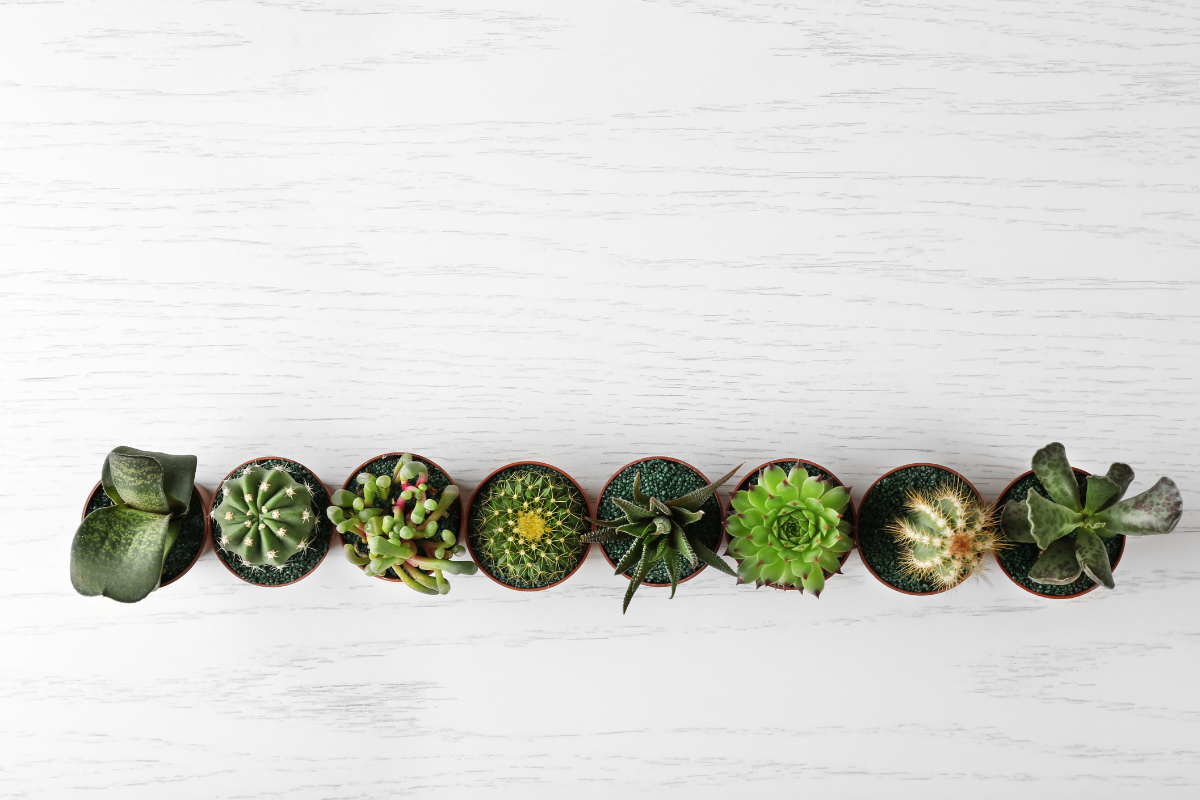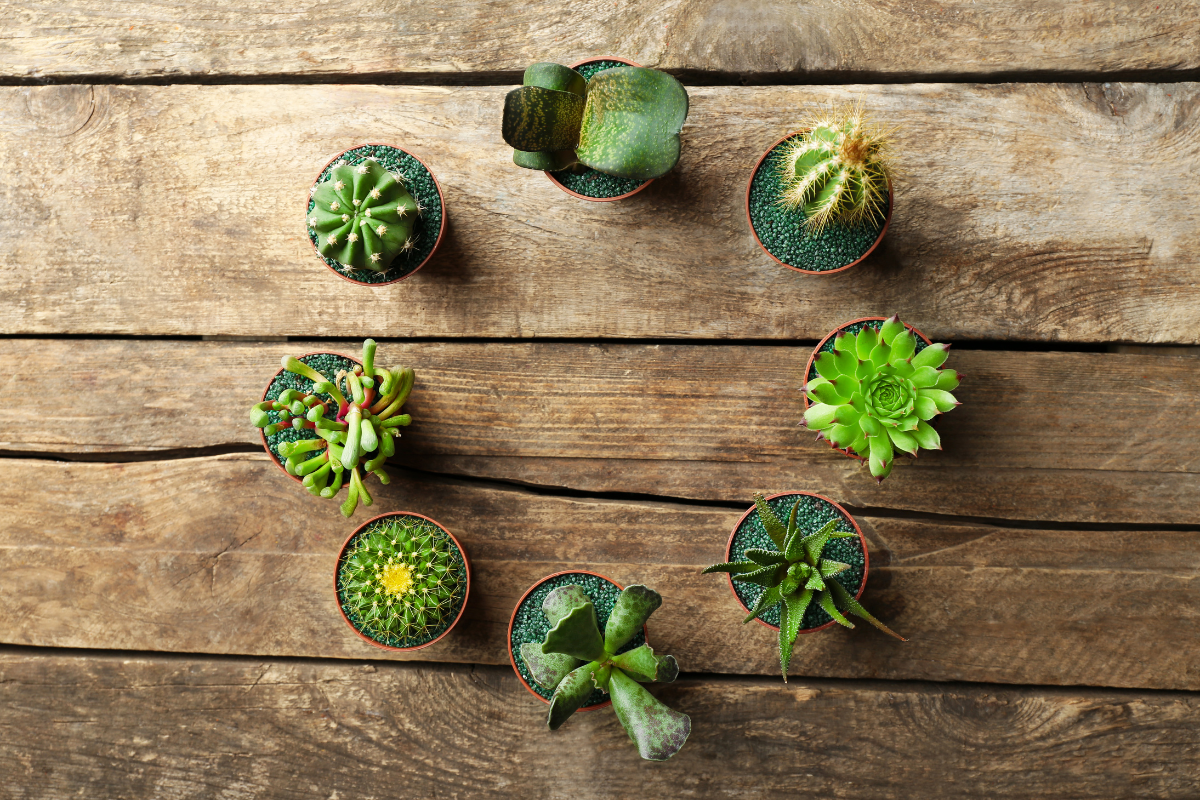
Aloe vera and other succulents are popular houseplants because they’re low-maintenance and attractive. However, these plants can quickly outgrow their space. Dividing succulents is a straightforward and easy way for gardeners to propagate new plants and manage the size of existing ones. This guide will walk you through the steps of dividing aloe vera and other succulents, providing tips and tricks to ensure success.
When To Divide Succulents
The first step in successfully dividing succulents is knowing when you need to do it. Generally, spring and early summer are the best times to divide these plants, as this coincides with their main growing season. Signs that a succulent needs division include overcrowding in the pot, visible offsets or “pups” growing around the base, the plant becoming too large for its current container, and reduced growth due to limited space. By recognizing these signs, you can take action at the right time for the health and longevity of your succulents.

How To Divide Succulents
Start by examining your plant carefully so you can understand what you’re dealing with and plan the division accordingly. Then, you can begin the division.
Assess the Plant’s Structure
To begin, gently remove the plant from its pot or, if it’s growing in the ground, clear away enough soil to see the crown and topmost roots. Look for the presence of natural divisions, where large plants may have several adult plants packed together, each with its own stem or crown and root system. Additionally, be on the lookout for offsets, which are new plants growing around the parent plant, often called “pups.”
Identify Suitable Division Points
Once the plant’s structure is clear, identify where to make divisions. Look for natural separation points between stems or crowns, and make sure you leave each division with an adequate root system to support new growth.
Prepare for Division
Before making any cuts, gather the necessary tools. You’ll need a clean, sharp knife or pruning shears, fresh potting soil suitable for succulents, new pots with drainage holes, and we also recommend wearing gloves.
Separate the Plant
When dividing the plant, begin by gently teasing apart natural clumps, being careful not to break stems. For tightly packed plants, use a clean, sharp knife to make precise cuts between divisions, making sure each one has a healthy portion of roots attached.
Tips for Successful Division
To increase the chances of success when dividing succulents, minimize damage to the plant by teasing apart roots gently and making clean cuts to reduce the risk of disease. Allow cut surfaces to callous over for a day or two before replanting, as this helps in forming a protective barrier against potential infections.

How To Plant Divisions
After successfully dividing the succulent, you need to plant the divisions properly for the new plants to thrive.
Choose the Right Potting Mix
Succulents require well-draining soil to prevent root rot. The best potting mix for these plants should be loose-textured and easily aerated, fast-draining, and specifically formulated for succulents or cacti. Avoid peat-based mixes, as they tend to retain too much moisture. If you use a standard potting mix, add gravel, perlite, or coarse sand to improve drainage.
Select Appropriate Containers
When choosing pots for succulent divisions, pick something with drainage holes that’s size appropriate for the division’s root system. For larger, heavier plants, opt for deeper pots to provide stability and support.
Start Planting
To plant the divisions, start by filling the bottom of the pot with a layer of potting mix. Place the division in the pot, keeping the top of the root ball a couple of inches below the rim. Fill around the roots with more potting mix, gently tamping down to remove air pockets. For offsets or pups, bury the stem up to the first pair of leaves for better stability and anchorage.
Caring for Newly Divided Succulents
You need to give your new succulent divisions proper care so that the plants can flourish and remain healthy.
Proper watering is critical for succulent care, especially for newly divided plants. Wait a day or two after planting before watering to allow any cuts to callous over, and then water sparingly, as overwatering can easily kill succulents. Finally, make sure you never let water sit in the drainage tray, as standing water can lead to root rot.
To help newly divided succulents thrive, place your plants in a bright, protected spot with indirect sunlight for the first few weeks. Gradually acclimate plants to more direct light as they establish. Maintain a warm temperature and good air circulation around the plants to promote healthy growth and prevent fungal issues.
How To Grow Aloe Vera Babies
Aloe vera is known for producing offsets or “pups,” which are an excellent way to propagate new plants. This section focuses on the specific process of growing aloe vera babies.
To grow aloe vera babies, look for small offshoots growing around the base of the parent plant. Wait until pups are about 3 to 4 inches tall before removing them. Gently remove soil around the pup to expose its connection to the parent plant. Use a clean, sharp knife to separate the pup with some roots attached to increase the likelihood of successful transplantation.
After removing the pups, allow the cut end to dry and callous over for a day or two. Plant the pup in a small pot with a well-draining cactus or succulent potting mix. Water sparingly, allowing the soil to dry out completely between waterings. Place the pot in a bright location with indirect sunlight to encourage healthy growth.
Managing Pests and Diseases
Succulents are generally hardy and resistant to many pests and diseases. Still, they’re not immune to diseases. Being proactive about possible pest issues and diseases is the best way to help your succulent garden thrive. The most common pests affecting succulents are mealybugs, aphids, and spider mites. Regularly inspect your plants, especially in hidden areas such as the base of leaves or within rosette structures, where these pests tend to congregate. Early intervention makes control more manageable and limits damage.
For light infestations, physical removal using a soft brush, cotton swab, or gently spraying the plant with a mixture of water and mild soap can help. Be cautious with chemical insecticides, as some may damage succulents or affect beneficial insects. Systemic insecticides can provide long-term control but should be used as a last resort. Keeping the environment clean by removing plant debris and avoiding over-fertilization will lead to generally healthier plants that are less prone to pest problems.
For diseases, ensuring good air circulation and proper watering are your first defenses against rot and fungal infections. If a plant is infected, remove affected parts promptly and treat the area with fungicidal solutions to prevent the spread of disease to other parts or adjacent plants.
When introducing new succulents to your collection, quarantine them for at least two weeks. This isolation period gives you time to observe any hidden pests or diseases so you can prevent the spread to your other plants.
Frequently Asked Questions
Can you pot aloe vera with other succulents?
Yes, you can pot aloe vera with other succulents, but it’s important to choose companions with similar water and light requirements. Ensure the pot is large enough to accommodate all plants and use a well-draining soil mix suitable for succulents.
Can you cut a piece of aloe vera plant and replant it?
While it’s possible to grow a new aloe vera plant from a leaf cutting, the success rate is much lower compared to propagating from pups. Aloe vera leaf cuttings may rot before they can develop roots. It’s generally more reliable to propagate aloe vera from offsets or pups.
Can you propagate aloe plants from just clippings?
Propagating aloe vera from leaf clippings is challenging. Unlike some succulents that easily root from leaves, aloe vera typically doesn’t propagate well this way. It’s best to use offsets or pups for propagation.
How big do aloe vera pups need to be to have their own root system?
Aloe vera pups typically develop their own root systems when they’re about 3 to 4 inches tall. At this size, you can separate them from the parent plant and pot them on their own.
What is the best method for separating and repotting aloe vera offsets?
The best method for separating and repotting aloe vera offsets is to gently remove soil around the pup, exposing the connection to the parent plant.
Use a clean, sharp knife to cut the pup away, ensuring it has some roots attached. Allow the cut to callous for a day or two, then plant the offset in well-draining soil. Water sparingly until the plant establishes itself in its new pot.






Leave a Reply